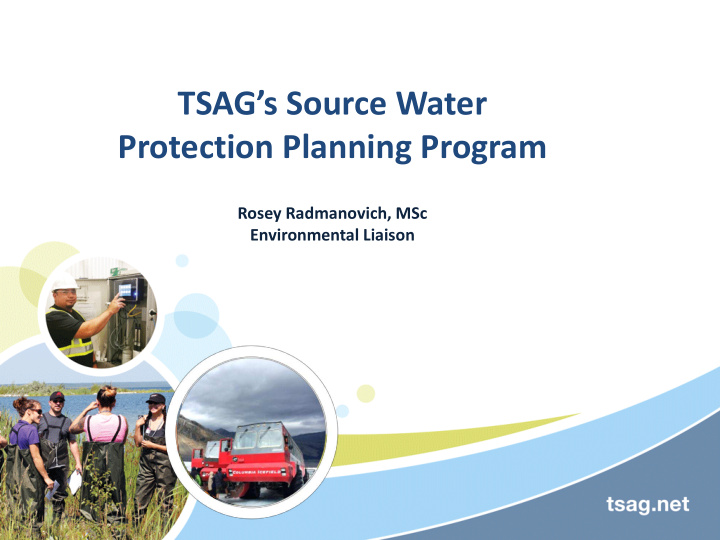



TSAG’s Source Water Protection Planning Program Rosey Radmanovich, MSc Environmental Liaison
What is Source Water? • Untreated sources of drinking water – Lakes – Rivers and streams – Aquifers
Source Water Protection Planning 101 • Process to protect drinking water sources from contamination – Surface water – Groundwater
Source Water Protection Planning 101 • Watershed planning approach – Inventory land uses – Inventory water use
1 Form working Review/ group Update Source Water Protection Implementation Identify risks Actions
Example: Improperly maintained cisterns • Decide how much of a risk to source water
Example: Improperly maintained cisterns • Current mitigation actions – what is already being done? – Testing by CHR – Public works cleans cisterns when needed
Example: Improperly maintained cisterns • Proposed mitigation actions – what could be done? – Inventory cisterns – Inspect condition – Fix or replace cisterns as needed – Establish a cistern cleaning crew – Clean cisterns on an annual basis
Implementation Planning • Prioritize mitigation actions • Identify funding sources and partnerships • Set timelines
Community Feedback • Host open-house(s) or other community engagement events to collect feedback on the plan – Any risks missed – Any additional mitigation actions
The Plan End up with a community-based, community- driven plan that outlines all of the risks to water and what the community would like done to protect water
A Living Document • On a regular interval the working committee reviews: – Membership (working group) – Land use assessment – Management actions – Implementation (Steps 1-4)
Benefits • Identifies and ranks land use risks to source water – Allows prioritization of resources • Helps the community decide what steps should be taken and when – Long term plan that lays out a strategy for accessing funding and additional resources
Benefits • Lists who can be partnered with to work on which challenges • Raises awareness about water within the community
Benefits • Fosters relationship building – Neighbouring communities – Watershed Planning and advisory councils (WPACs) – Other organizations within the province
Program Update • 15 First Nations in Alberta have developed source water protection plans with TSAG • Many implementation success stories – Decommissioning abandoned water wells – Illegal dumpsite cleanup – Collaboration and partnerships – Coordination with other community plans – Community-based monitoring initiatives • But not as many as we would like to see…
Social Sciences and Humanities Research Council – Call for Proposals “This funding will support community gatherings, workshops, or other events or outreach activities that will $$$ $$$ mobilize knowledge, facilitate dialogue and knowledge sharing”
Source Water Protection Planning Retreat January 22 & 23, 2019 Banff, Alberta
Retreat Objectives 1. Bring communities together to share knowledge around water protection and planning 2. Identify common/shared challenges or barriers to source water protection 3. Share knowledge, strategies, etc. around solutions and identify potential solutions to overcome barriers
Barriers to SWPP Implementation • Inadequate capacity – Financial – Human resources – Institutional – Social – Technical
Community-Driven Solutions • Hiring of an Implementation Coordinator • Hiring of a Funding and Proposal Coordinator • Dedicated funding for source water protection plan implementation • Strategies to build partnerships and increase collaboration • Stronger cultural connections to water
Barriers to SWPP Implementation • Inadequate capacity – Financial – Human resources – Institutional – Social – Technical
Support for Source Water Protection Plan Implementation
Sustainable Communities • Provide training courses on solid waste management • Transfer station planning • Waste diversion, community composting, community gardens • Community education and outreach • Assist with clean-up of illegal dumpsites
Source Water Success: Saddle Lake Cree Nation • Completed plan spring 2017 • Identified unauthorized dump sites as a high source water risk
Source Water Success: Saddle Lake Cree Nation • Partnered with TSAG to utilize youth and existing community programs to clean up sites
Source Water Success: Saddle Lake Cree Nation
Project Design Support and Proposal Review • Assist with the technical side of project planning • Assist with grant application and project proposal review • Facilitate networking
Use of Drones to Inform Cumulative Environmental Effects Planning • Pilot project – Working with 3 communities to assess and monitor environmental risks identified in community plans
Potential Applications • Location and assessment of illegal dump sites • Coarse riparian area assessment • Monitoring surface water levels • Monitoring reclamation sites
Private Drinking Water Systems Assessment
Private Drinking Water Systems Assessment
Lake Monitoring with ALMS • Alberta Lake Management Society – Not for profit that promotes understanding and comprehensive management of lakes, reservoirs, and their watersheds
LakeWatch Program • Volunteer-based water quality monitoring program • Provide: – Training – Equipment – Sample analysis costs • Just need a community contact with a boat!
LakeKeepers Program • Working on partnering with TSAG for us to provide training support for interested First Nations
“There is no greater medicine than water – it is foundational, our very beginnings, it reminds us where we came from, our first environment in the womb.” Elder, Chiefs of Ontario 2006 Questions? For more information: Rosey Radmanovich, MSc. Environmental Liaison Phone: 780-483-8601 Email: rradmanovich@tsag.net
Recommend
More recommend